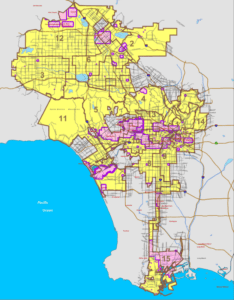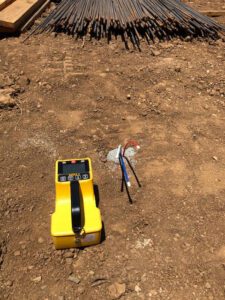LADBS Methane Gas Soil Testing is the First step in the Three-step LADBS Methane Mitigation Process. If an LADBS Plan Checker requires a Methane Test, be sure to ask the 5 Important Methane Testing Questions.
Is my Property in the Methane Zone or Methane Buffer Zone?
When Methane Testing, the first step should be to establish whether LADBS will require the methane mitigation process for your project.
Based on the location of historical oil wells, the LADBS has created a Methane Zone map. It outlines areas that have potential hazards of methane gas migration. Projects within the Methane Zone or the Methane Buffer Zone, the project will require a Methane Mitigation System. This is per the LADBS Methane Mitigation Code requirements.
Rather than referring to the Methane zone map created by LADBS, a more efficient method of establishing the Methane Classification Hazard is to refer to either ZIMAS or Navigate LA. For instance, ZIMAS and Navigate LA are programs the City of Los Angeles developed to organize all data for properties located within the LADBS Jurisdiction.
So, f a property lies within the Methane zone, the next step is to find a Methane Mitigation Consultant. They will help conduct an LADBS Methane Test.
Are you an LADBS Licensed Methane Field Testing Agency?
LADBS has established guidelines for conducting Methane Tests within the LADBS building jurisdiction. The LADBS Site Testing Standards for Methane (LADBS Information Bulletin P/BC 2014-101) define the process for Methane Testing.
To enforce Methane Testing quality control, LADBS developed a Methane Testing Field License. Any consultant conducting a Methane Test within LADBS must hold the license.
Any complete Methane Test must abide by the LADBS Methane Testing Standards. To ensure that the Methane Soil Gas Test will be acceptable to the Los Angeles Department of Building and Safety’s Building Engineering Plan Checker. The most effective way to confirm that a consultant abides by the Strict Methane Testing standards is to request the Consultant’s Methane Field Testing Agency License Number.
The Los Angeles Materials Control section conducts background checks, Laboratory Inspections, and documentation process reviews as a requirement for LADBS Methane Testing field laboratory license approvals. LADBS Building plan checkers will not accept Methane Tests unless they submit along with the Certificate of Compliance for Methane Testing Data. Which holds the Methane Field Testing License number of the responsible Methane Testing consultant.
How will Tests on Methane be on a property?
According to the LADBS Methane Testing Standards, there is a specific testing methodology for any given scope of work and property size.
The Methane Testing Scope of work will consist of a series of Shallow and Deep Methane Test Probe holes.
Shallow Methane Test
Methane concentrations for the Shallow Methane Test will record as follows:
- A minimum of two per project site.
- At a rate of one sample per 10,000 SqFt.
Deep Methane Test
The location of Deep Gas Probes bases off the results from the Shallow Methane Test. Deep Gas Probes install where the highest concentration of methane soil gas are measure. Methane gas concentration and pressure measurements for the Deep Gas Probe Tests will be as follows:
- At least one methane gas probe set for every 20,000 SqFt of property (Minimum of two gas probe sets).
- Each Deep Gas Probe Set shall consist of three probes, installed at depths of 5, 10, and 20 feet below the lowest elevation of the building.
- Two sequential measurements shall be taken, with a minimum 24-hour interval following the Gas Probe Sets placement.
The number of Methane Testing boreholes placed by the Methane Testing Consultant is an essential aspect of the Methane Testing Process that a developer, contractor, or owner should manage and oversee. If the Methane Testing Scope does not comply with the LADBS Methane Testing Standard requirements, LADBS will reject the Methane Testing results.
Will Direct Push Drilling be used for my LADBS Methane Test?
LADBS Methane Testing Standards require Direct Push Drilling per the standards established by ASTM D6282 – Standard Guide for Direct Push Soil Sampling for Environmental Site Characterizations.
Drilling technologies have advanced significantly in the past decades. Environmental drilling technologies most often use a method called direct push drilling. This drilling method allows for a reduction in disturbances to the environment during the advancement of the borehole.
Direct push drilling can easily be described as hammering a nail into the ground; In doing so, a rod is directly pushed into the soil creating a void for the placement of the Methane Testing sample probes.
Direct Push drilling is a specialized technique requiring high-cost equipment and highly trained and skilled drillers. Due to the specialization of Direct Push drilling, it correlates to high drilling costs.
Methane testing consultants often save on drilling costs by advancing the Methane Testing Boreholes using a Hand Auger. Hand Auguring will result in a very intrusion drilling method which will likely affect the results of the Methane Test. It is unlikely that a hand auger will reach a minimum depth of 20 feet. LADBS will not accept Hand Augured Methane Testing drilling technologies.
Will you hit my underground utilities? Dig Alert or GPR?
Damaging underground utilities are the highest risk associated with conducting a Methane Test. Based on the scope required by LADBS, drilling is a minimum of 20 feet below the ground surface. It may go near underground utilities like gas lines, sewer lines, electrical lines, and irrigation systems. Along with water systems, and sewer systems are all traced through the property underground. When drilling, one of these lines may be hit, causing significant damage that could lead to further environmental concerns or explosion hazards if it is a gas line.
It is the responsibility of the Methane testing consultant to call DigAlert. It is California Law to contact DigAlert when you are drilling in southern California. DigAlert is a nonprofit company funded by the utility companies to manage the delineation of underground utilities. During any excavation or Drilling, DigAlert must be notified to dispatch the appropriate utility companies. So as to mark the locations for the underground utility lines at risk.
In some cases, the utility delineations of DigAlert are not sufficient. It may be required to conduct Ground Penetrating Radar (GPR). So as to identify underground utilities that DigAlert may not be able to locate. Ground Penetrating Radar emits electromagnetic waves and measures the reflection of the response of the waves. Voids or obstructions can be identified based on the discontinuities measured, including underground utilities. GPR allows consultants to scan the sub-surface and identify any utility lines, minimizing the risks associated with Methane Testing.
Next Steps after Methane Testing
Upon completing LADBS Methane Testing, the Methane Mitigation Consult will provide the Certificate of compliance. The Methane Testing Results will identify the Methane Mitigation Hazard Classification, which will range from Level 1 to Level 5.
Thus a Methane Testing Level will drive the Methane Mitigation requirements. The Methane Mitigation requirements will be outlined on a Methane Mitigation Design and will ultimately be implemented during the project’s Methane Mitigation Construction phase.


